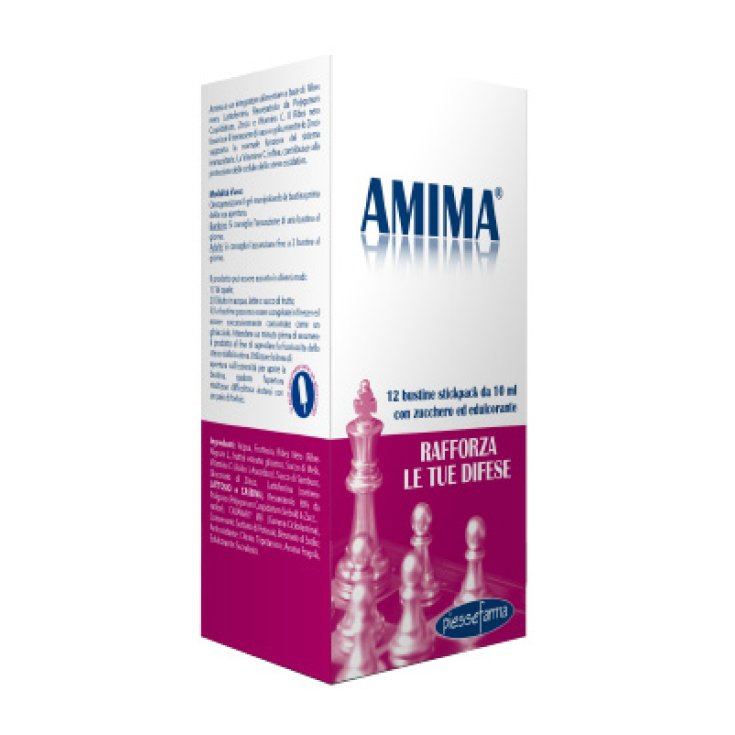Amima 12 Sachets
- Brand: PIESSEFARMA Srl
- Product Code: 975632136
- EAN:
- Availability: In Stock
- Purchase 3 items for 18.12€ each
- Purchase 4 items for 17.75€ each
- Purchase 5 items for 17.38€ each
Love
INFLUENZA and SEASONAL DISEASES
With the onset of the first cold weather, and in general with the sudden changes in temperature that can be observed during seasonal changes, there is an increased chance of getting sick. Symptoms such as:
sore throat
runny nose, commonly referred to as a "runny nose"
widespread pains
tiredness
cough
fever
vomiting and diarrhea
often accompanied by:
or aphonia
or muscle aches
or white patina on the tongue
or anosmia
or dry throat
or loss of balance
or asthenia
or leukopenia
or itchy nose
or chills
or headache
or itchy throat
or burning in the eyes
or stuffy nose
or runny nose
or abdominal cramps
or nausea
or feeling cold
or joint pain
or congestion
or paleness
o edema of the nasal mucosa
or night sweats
CAUSES
Cold weather, rain, drafts, cold wind and air conditioning are among the major risk factors empirically recognized for what concerns seasonal diseases. The increased susceptibility in such circumstances is probably due to the temporary lowering of the defenses of the nose and throat, which occurs following exposure to cold or excessively dry drafts.
The respiratory tracts are lined with vibrating cilia, which with their movements continually push out the mucus viscous substance that allows to maintain the right humidity and the right temperature of the air in the respiratory tree and that ensures a continuous cleaning of the passages air entraining the microorganisms and pushing them outwards. The complex function determined by mucus and cilia is called "mucociliary clearance". Viruses and bacteria can exploit the inhibiting action of cold on the motility of the eyelashes, to infect the upper respiratory tract.
Not only the flu, but numerous other bacterial or viral diseases can present with very similar symptoms. Even the so-called para-flu syndromes can involve the respiratory tract, sometimes with the onset of fever (usually within rather low temperatures). In some cases, however, there are no respiratory symptoms, but diarrhea and vomiting.
The flu, cold and flu-like respiratory infections are caused by different viruses:
- Influenza is a disease caused by viral agents belonging to the Orthomixovirus genus that infect the airways (nose, throat and lungs); generally, they are more aggressive and responsible for more intense symptoms than those caused by flu-like respiratory infections.
- Parainfluenza viruses include Adenovirus, Coronavirus, Enterovirus and numerous other pathogens, which affect the respiratory and gastrointestinal systems.
TREATMENT
In the case of flu and parainfluenza syndromes, the therapy is symptomatic, it includes rest in a comfortable environment and drugs, such as antipyretics, antiemetics against vomiting, cough syrups, mineral salts to avoid dehydration in case of gastrointestinal problems. Considering that the flu does not depend on a bacterial infection, antibiotics are contraindicated and their use is reserved exclusively in the event of complications and / or in the case of bacterial co-infections. Antiviral drugs are sometimes recommended to shorten the duration of illness and to relieve flu symptoms; the administration of these drugs is useful for the purpose of recovery only when it occurs within 48 hours of the onset of symptoms.
As there is no real treatment available in case of influenza and parainfluenza syndromes, it is preferable to act preventively by strengthening the immune system and thus helping the body to fight infections.
In the treatment of allergic syndromes it is necessary to try to avoid exposure to the allergen (although this is not always possible) and to limit the symptoms by acting on the chemical mediators involved in the inflammatory responses that are triggered during allergic reactions.
Format: 12 stickpack sachets of 10ml

